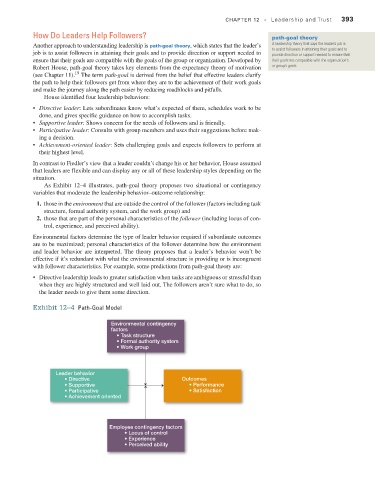Page 394 - Fundamentals of Management Myths Debunked (2017)_Flat
P. 394
How Do Leaders Help Followers? CHAPTER 12 • Leadership and Trust 393
path-goal theory
Another approach to understanding leadership is path-goal theory, which states that the leader’s A leadership theory that says the leader’s job is
job is to assist followers in attaining their goals and to provide direction or support needed to to assist followers in attaining their goals and to
provide direction or support needed to ensure that
ensure that their goals are compatible with the goals of the group or organization. Developed by their goals are compatible with the organization’s
Robert House, path-goal theory takes key elements from the expectancy theory of motivation or group’s goals
19
(see Chapter 11). The term path-goal is derived from the belief that effective leaders clarify
the path to help their followers get from where they are to the achievement of their work goals
and make the journey along the path easier by reducing roadblocks and pitfalls.
House identified four leadership behaviors:
• Directive leader: Lets subordinates know what’s expected of them, schedules work to be
done, and gives specific guidance on how to accomplish tasks.
• Supportive leader: Shows concern for the needs of followers and is friendly.
• Participative leader: Consults with group members and uses their suggestions before mak-
ing a decision.
• Achievement-oriented leader: Sets challenging goals and expects followers to perform at
their highest level.
In contrast to Fiedler’s view that a leader couldn’t change his or her behavior, House assumed
that leaders are flexible and can display any or all of these leadership styles depending on the
situation.
As Exhibit 12–4 illustrates, path-goal theory proposes two situational or contingency
variables that moderate the leadership behavior–outcome relationship:
1. those in the environment that are outside the control of the follower (factors including task
structure, formal authority system, and the work group) and
2. those that are part of the personal characteristics of the follower (including locus of con-
trol, experience, and perceived ability).
Environmental factors determine the type of leader behavior required if subordinate outcomes
are to be maximized; personal characteristics of the follower determine how the environment
and leader behavior are interpreted. The theory proposes that a leader’s behavior won’t be
effective if it’s redundant with what the environmental structure is providing or is incongruent
with follower characteristics. For example, some predictions from path-goal theory are:
• Directive leadership leads to greater satisfaction when tasks are ambiguous or stressful than
when they are highly structured and well laid out. The followers aren’t sure what to do, so
the leader needs to give them some direction.
Exhibit 12–4 Path-Goal Model
Environmental contingency
factors
• Task structure
• Formal authority system
• Work group
Leader behavior
• Directive Outcomes
• Supportive • Performance
• Participative • Satisfaction
• Achievement oriented
Employee contingency factors
• Locus of control
• Experience
• Perceived ability

